Major changes are reshaping 8th Air Force, overseer of the nation’s fleet of nuclear-capable B-2 and B-52 bombers and other assets, including intelligence-surveillance-reconnaissance aircraft and cyber warfare units.
The 8th, headquartered at Barksdale AFB, La., is shorthand for “long-range conventional and nuclear strike.” It is launching a new “nuclear rotation” for members of its three bomber wings and will shed oversight of its non-bomber wings later this year.
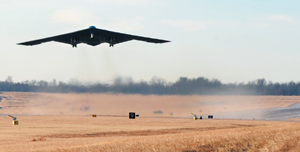 |
A B-2 takes off from Whiteman AFB, Mo., while another lines up for its turn. |
This new focus on the nuclear mission is part of 8th Air Force’s coming shift from Air Combat Command to Air Force Global Strike Command. Global Strike Command, the service’s nascent nuclear-centric major command, should commence operations at the end of September.
USAF is working to re-instill an emphasis on strategic and nuclear deterrence in “the old traditional sense,” harkening back to the days of Strategic Air Command, says Lt. Gen. Robert J. Elder Jr., 8th Air Force’s outgoing commander.
“What we have been working on aggressively … is to redevelop that concept,” Elder said.
The 8th is working to develop airmen who are steeped in deterrence theory and able to articulate the continued importance of the nuclear mission to others across the Air Force and the entire Department of Defense.
“We are now building a cadre of people who understand what seems foreign to most people,” said Elder, who took over 8th Air Force in June 2006 and is now retiring, effective July 1. That foreign concept, he explained, is,“We actually put bombs on airplanes [and] don’t want to drop them.”
As head of 8th Air Force, Elder has also been US Strategic Command’s joint functional component commander for global strike, with responsibility for planning and executing STRATCOM’s strategic deterrence and global strike operations. In his post, he has also commanded Task Force 204, which oversees the nuclear bombers and U-2 and RC-135 surveillance and reconnaissance aircraft supporting STRATCOM’s global strike mission.
The Air Force approved Global Strike Command to strengthen its nuclear stewardship after the unauthorized transfer of nuclear-tipped cruise missiles aboard a B-52 in August 2007, and the mistaken shipment of Minuteman III components to Taiwan in 2006.
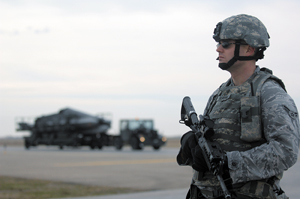 |
A1C Robert Burnham, 5th Security Forces Squadron stands guard at Minot AFB, N.D., as weapons are transported during a nuclear weapons safety exercise. |
Enter the Global Deterrence Force
The Air Force announced in April that Barksdale is the preferred location for Global Strike Command’s permanent headquarters, pending the completion of the environmental impact analysis required by law. A final decision is expected this month. Bolling AFB, D.C., has been serving since January as Global Strike Command’s provisional seat.
8th Air Force will be joined by 20th Air Force as Global Strike Command’s two numbered air forces. Located at F. E. Warren AFB, Wyo., 20th Air Force oversees the nation’s Minuteman III ICBMs at bases in Montana, North Dakota, and Wyoming.
Concurrent with preparations for the move to the nuclear-centered MAJ-COM, the “Mighty 8th” is incorporating the Global Deterrence Force nuclear rotation into its routine. Under this construct, the nation’s two B-52 wings—Barksdale’s 2nd Bomb Wing and the 5th BW at Minot AFB, N.D.—spend alternating one-year intervals concentrating on the nuclear and strategic deterrence mission.
The 509th BW at Whiteman AFB, Mo., the Air Force’s sole B-2 wing, will always be part of the Global Deterrence Force, but its two flying squadrons will switch off responsibilities every six months. They will alternate between conventional preparations and deployments—such as those in support of US Pacific Command’s bomber force rotations to Guam—and a dedicated nuclear focus.
“We are pretty excited about the GDF,” said Elder. The goal is to have the wings in the GDF “totally focused” on the strategic deterrence mission.
Elder differentiates between strategic deterrence and nuclear deterrence. “In some cases,” he explained, “the things that STRATCOM wants us to do for deterrence purposes might not always involve nuclear [weapons], although, most of it, quite frankly, is. But we don’t limit to that.”
The 2nd BW recently concluded the inaugural GDF rotation, which, in order to sync the schedules of the wings for future rotations, did not last a full year. The 5th BW has now rotated in for the first full-year stint.
Elder said that the inaugural GDF rotation provided valuable lessons.
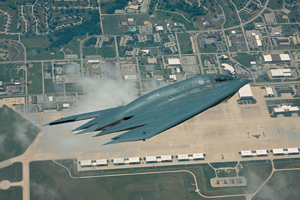 |
A nuclear-capable B-2 stealth bomber soars over Whiteman AFB, Mo. |
“First of all, what we have found is that by taking this approach and having that kind of focus, it actually makes it easier to have people perform the mission than just trying to do it in little bits and pieces,” he said. The Global Deterrence Force implementation “turned out to be somewhat easier than we thought.”
At the same time, the experience highlighted some shortfalls, such as the need for more security forces personnel and the recognition that some alert facilities will require renovation or replacement. The alert facilities had not been used for that purpose since the first President Bush took SAC’s bombers off continuous nuclear alert in 1991. “In the case of Whiteman and Offutt,” Elder said, “we think we are going to need to have entirely new alert facilities built.”
Another emerging lesson is the recognition that the nuclear mission is a wing-level endeavor and a garrison operation. Conventional bomber deployments of the sort that have been common in recent years are more squadron-centric, said Elder.
“When we moved from being a garrison-type force to an expeditionary Air Force, to support all of the theater things that we were doing, we somewhat forgot our days as a strategic deterrence force,” he explained. “We basically went through a big cultural change to get people to embrace the concept of an expeditionary Air Force—and, in some ways, we are having to reverse that for the nuclear mission.”
In fact, he said, the bomber units need to be able to shift between the garrison and expeditionary mind-set as they rotate out of the GDF and into preparations for conventional deployments.
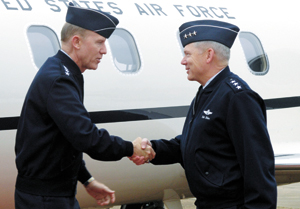 |
Lt. Gen. Robert Elder (r), commander, 8th Air Force, greets Gen. John Corley, ACC commander, at Barksdale AFB, La. |
Four BUFF Wings
“That is a big complexity for us,” he said.
As part of the GDF, the Air Force is establishing a new operational B-52 flying squadron at Minot. That will give the Air Force two operational BUFF wings at Minot and two at Barksdale. Elder said the plan is for the unit to stand up this fall and then be ready for combat, if called upon, next summer.
The new flying unit, which was still awaiting its designation as of early April, will have slightly more than 900 personnel and a full complement of 11 front-line jet aircraft and one backup—the same as the three other B-52 operational flying squadrons.
Having the four squadrons of 11 B-52s and the consistency of having two at Minot and two at Barksdale “is really important in order to be able to make this [GDF] rotation work smoothly,” he said.
There is “a pretty good process in place” to churn out the trained aircrews, Elder said. Air Force Reserve Command’s 93rd Bomb Squadron, located at Barksdale, is assuming the lead for B-52 training under a plan approved in March by Gen. Norton A. Schwartz, Air Force Chief of Staff.
The Reserve unit is switching from being a combat-coded squadron to the formal training unit. It will be augmented by members of Barksdale’s 2nd BW under an active association. This consolidated training mission will add nearly 300 airmen to Barksdale, Elder said.
With this arrangement, “we think we are going to be able to ramp up aircrew production to pretty quickly meet that need,” said Elder, adding that “the bigger problem” is in fielding enough experienced maintainers.
“Quite frankly, we don’t have sufficient maintainers today,” he said. In fact, the Air Force estimates that it may take up to 10 years to fill all of the higher level maintainer positions for the new squadron—and that’s assuming that the bomber force continues to receive personnel authorizations as a high priority.
USAF is also in the process of reopening a nuclear weapons storage area at Barksdale for the munitions that would be used by the 2nd BW’s B-52s. It will join the weapons storage area operating at Minot for the 5th BW.
“It makes more sense for your weapons storage areas to be co-located with your airplanes,” explained Elder.
“The bigger implication,” he added, is that if there is an emergency or attack on one base, that “doesn’t mean that you have lost all of your capability.” The Air Force hopes to have Barksdale’s new nuclear weapons storage ready in Fiscal 2010.
Elder said all three legs of the strategic nuclear triad are important, including the land-based ICBMs and the Navy’s Trident submarine-launched ballistic missiles. The nuclear-capable bombers offer unique advantages, such as visibility, flexibility, and survivability, to the nation’s strategic triad, he said.
Bombers are visible in the sense that they can signal intent to both allies and potential foes during a crisis if the United States places the bombers on alert or sends them into the air. The bombers are flexible because they can carry both conventional and nuclear weapons. They are recallable once airborne, unlike the Air Force’s ICBMs and the Navy’s ballistic missiles.
When the bombers are placed on alert with advanced strategic warning, they are also quite survivable, Elder said.
The bombers also “complicate your adversaries’ defensive problems dramatically,” he said. They require different types of defensive preparations than those used to deal with ICBMs and SLBMs.
Bombers also provide a hedge against the possibility that some technological breakthrough could give the adversary a perceived advantage over US ballistic missiles.
Accordingly, Elder said the bombers would continue to be valuable assets in a smaller-size deterrent force.
In April, several weeks after Elder spoke with Air Force Magazine, President Obama announced that the US would enter into negotiations with Russia later this year to seek further reductions in the two nations’ nuclear forces.
The Air Force has done a good job in upgrading its B-2 and B-52 fleets, Elder said, but gradual “losses in capability” will degrade the bomber leg’s deterrent as time goes on.
Since effective deterrence is regarded as a function of capability and perceived will, the nation could “run into a bind” if it doesn’t have a credible new capability at some point. That’s why a new bomber, which notionally would have the same level of stealthiness as the F-22, was considered so important to Air Force strategic planners, Elder said shortly before Defense Secretary Robert M. Gates announced his intent in April to delay the “2018 bomber” program.
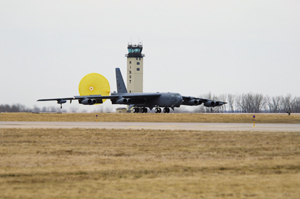 |
A B-52H from Barksdale pops its chute at Minot, ready to participate in a multiwing nuclear operational readiness exercise. |
Looking to the 2018 Bomber
“If you have this kind of an airplane that can carry conventional and nuclear weapons and can penetrate into a highly defended area and hold a target at risk that is holding us at risk in some other way, now we have a viable capability,” Elder said.
Because a new bomber could carry either conventional or nuclear weapons, “another country would recognize that we have the will to use it,” Elder said. “And so, our strategic deterrence value goes up dramatically, and that is why I am such a big proponent for this capability.”
The Air Force’s reliable but lumbering B-52s are already limited to low-threat environments, while the stealthy B-2s, of which only 20 airframes exist, are considered a nighttime-only system in high-threat environments.
Gates said the bomber’s development would be put off until there is “a better understanding of the need, the requirement, and the technology.” The Pentagon will examine all its strategic requirements during this year’s Quadrennial Defense Review, Nuclear Posture Review, and in light of the US-Russia arms control negotiations, Gates added.
Elder worries about a major delay in the fielding of a new bomber, and senior Air Force officials had previously said the 2018 date was derived from emerging intelligence estimates about possible future threats and improving air defense capabilities. The fact that USAF’s nuclear-tipped Air Launched Cruise Missiles have about a decade of service life remaining is another factor driving the 2018 date. Elder said in April a new bomber would allow the Air Force to “change the approach” for delivering nuclear weapons.
While the Air Force has some capacity to work through a minor delay, a significant schedule slip “would be problematic,” Elder said. “The nation needs this capability because of the options that it provides.”
The fate of the next generation bomber is expected to be a major source of controversy during the current QDR deliberations and as the 2010 defense budget request is debated in Congress this summer.
